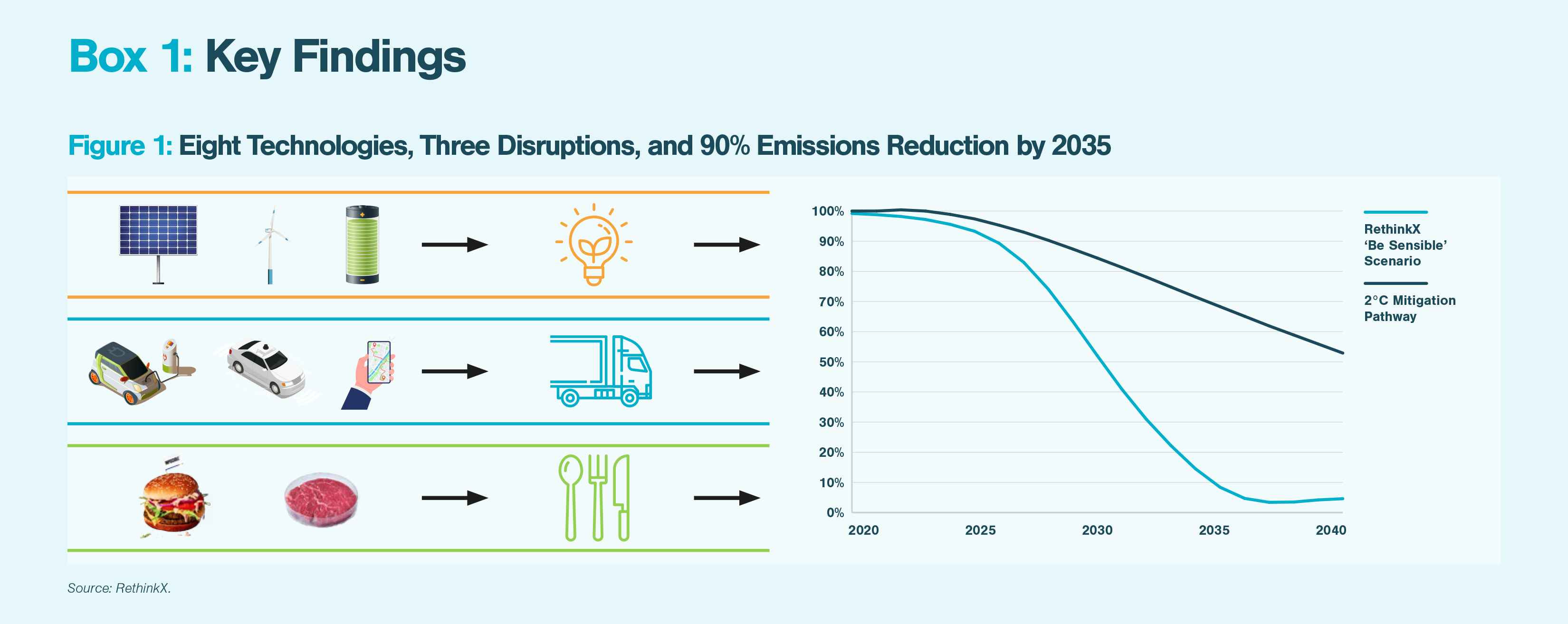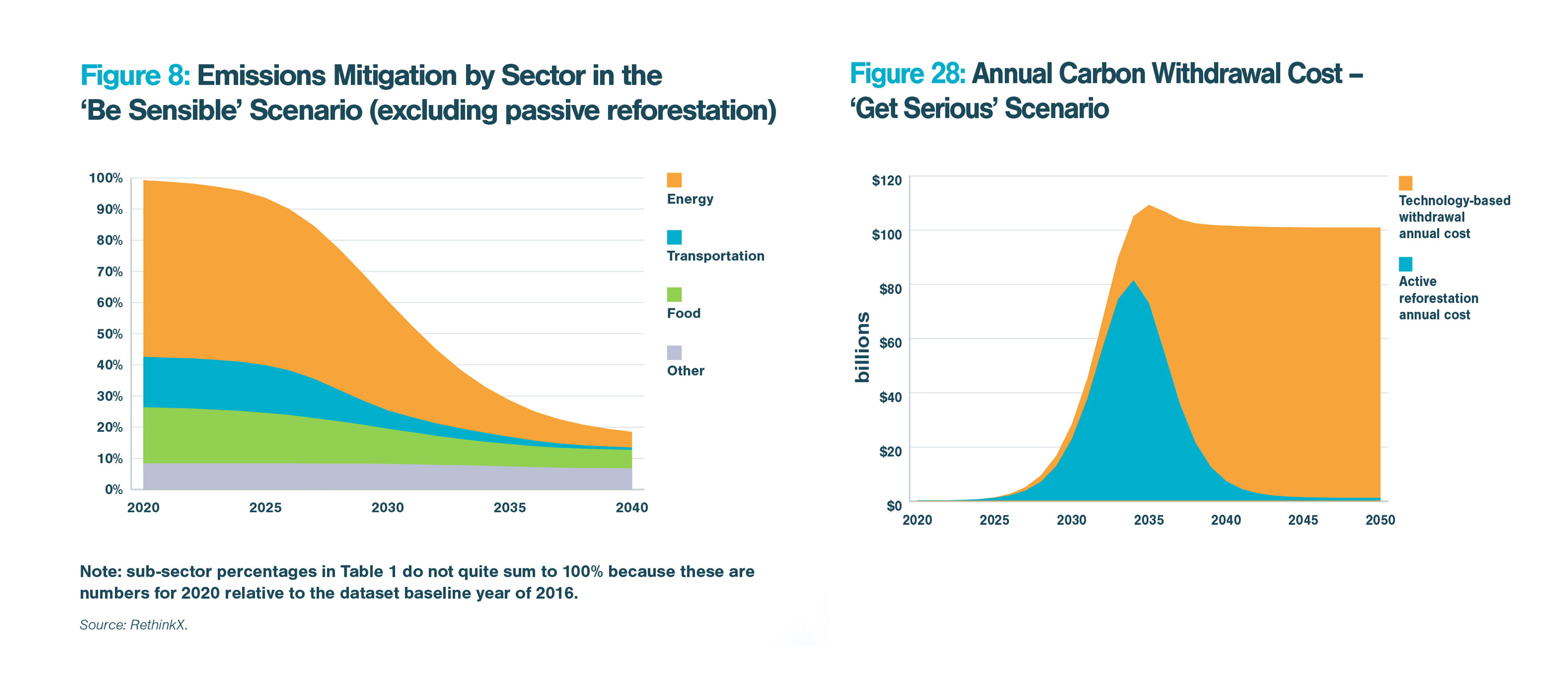Why the transportation industry should look forward to “TaaS disruption" — Part 3

In the final article of a three-part series, we're speaking to researcher Dr. Bradd Libby about the important role technology plays in TaaS disruption.
On the heels of Part 1: Electrification, and Part 2: Autonomous Vehicles, the third and final article exploring Transportation-as-a-Service (TaaS) reveals how technology is driving the evolution towards sustainable, clean energy and food production. Now and in the future.
But not only that. Thinktank RethinkX, creators of the TaaS model, anticipate key technologies that will help us reach and exceed our current climate targets. We'll have more than anticipated available land due to cellular food production, cleaner oceans and air due to less expensive carbon withdrawal, and zero CO2 emissions thanks to electrification and autonomous driving.

As mentioned in Part 1, the above table illustrates the eight core technologies RethinkX believes will disrupt global industries: solar, wind, battery, precision fermentation, cellular agriculture, EVs, AI, and TaaS.
Image credit: RethinkX
What's holding us back?
In their 2021 report, “Rethinking Climate Change" RethinkX proposes three emissions scenarios: “Be Sensible", “Get Serious" and “Get Stuck". Each focuses on how technology can mitigate climate change and increase the productive disruption of the three leading CO2-producing industries: transportation,energy and agriculture.

In the road transportation sector, decarbonization will run parallel to TaaS disruption, without lag. No additional technologies are required beyond SWB, A-EVs, and PFCA.
Image credit: RethinkX
Why do you think people underestimate the power of technology to stop and reverse the effects of climate change?
Dr. Bradd Libby (BL): “One of the authors of 'Rethinking Climate Change', Dr. Adam Dorr says people often forget that new technologies are driven by reinforcing feedback loops — the more we make of something, the cheaper it can be made per unit. The cheaper it is, the more it will sell. The more it sells, the more we can make of it.
"Ten years ago, few people had ever seen an electric car, today they are revolutionizing the car industry. Entire industries can be radically reshaped in just 10 or 15 years by technologies that benefit from reinforcing feedback loops."
Can you summarize how societies and governments can go from research and development (R&D) to “deploy and scale" within the transportation sector?
BL: “Governments, companies, organizations and individuals who wish to reduce emissions should focus on accelerating the adoption of SWB, A-EVs, TaaS, and PFCA, rather than on austerity.
"And, they should remove barriers to the three key disruptions by streamlining market design, breaking up rent-seeking utility monopolies, ensuring that individuals have the rights to produce energy, transportation and food services [using the new technologies]...."
RethinkX: 5 policy recommendations |
|---|
|
|
|
|
How will the reduction of emissions in the transportation, energy, and food sectors, via technology, improve other areas of society including commerce and the environment?
BL: "New technologies tend to both expand existing markets and create entirely new ones by supporting novel business models and forms of value creation. As stated in the report, the combination of superabundant clean energy, electric and autonomous vehicles and machines... will transform the economics of both reforestation and technology-based carbon withdrawal. This makes the three disruptions doubly essential for achieving a complete climate change solution.
"Clean technologies are inherently decentralizable and democratizing and will therefore allow less-developed areas to leapfrog over previous barriers... lift their disadvantaged populations into prosperity, and level the playing field between rich and poor economies."
To reinforce a key message of the RethinkX report*, at the core of our environmental crisis is a “mindset problem". People disregard the nonlinear nature and speed of (technological) change, resulting in a limited perspective with which to examine problems and solutions.
The core message of “Rethinking Climate Change" is not only how to solve the climate crisis, but also how to set ourselves up for a future of cascading economic and environmental development, built upon ethical, sustainable technology-driven systems.
Disruption occurs when a new technology of equal or greater capability, relative to cost, becomes available... after which the incumbent technologies are replaced very swiftly... often within as little as fifteen years.
RethinkX is an independent think tank that analyzes and forecasts the speed and scale of technology-driven disruption and its implications across society. They use the Seba Technology Disruption Framework™ to capture the interactions between technology, business models and market forces to forecast the scope, speed and scale of technology-driven disruption and its implications across key market sectors.
Dr. Bradd Libby was interviewed on December 1st, 2021 via Zoom.
*Reference: “Rethinking Climate Change", RethinkX, 2021
Have your say
Sign up for our newsletter
Why sign up:
- Latest offers and discounts
- Tailored content delivered weekly
- Exclusive events
- One click to unsubscribe